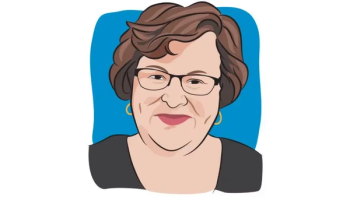
- CURE® Spring 2021 Issue
Tag Teaming Liver Cancer Care
As part of the “Speaking Out” video series, CURE® spoke with Dr. Laura M. Kulik about the basics of liver cancer, highlighting the need for a multidisciplinary approach to care.
With more than 40,000 cases of liver cancer diagnosed each year, it is vital that patients better understand their disease. Moreover, receiving care from a multidisciplinary team could change many patients’ outcomes.
As part of the “Speaking Out” video series and on behalf of Blue Faery: The Adrienne Wilson Liver Cancer Association, CURE® spoke with Dr. Laura M. Kulik, a professor at Northwestern University’s Feinberg School of Medicine in Chicago, about the types and stages of liver cancer, as well as treatment options with a multidisciplinary approach.
CURE®: What are the types of liver cancers in adults? How do they differ from one another?
Kulik: That’s an important question. I often hear people say, “Oh my, someone died of liver cancer,” but most cancers in the liver will be metastatic, meaning they’re coming from another organ. When people have primary liver cancer it means the cancer originated in the liver itself, it’s not coming from somewhere else.
The (most commonly diagnosed type) of liver cancer is hepatocellular carcinoma, or HCC. The way I describe this to patients is the analogy of a tree: you have a tree with a trunk, branches, and then all the way up to the tiny leaves. If you have a cancer of the leaves, those are equivalent to the liver cells, and that’s called hepatocellular carcinoma. That’s a cancer that we see (more than) 80% of the time in people with underlying liver disease, specifically cirrhosis — which is in the scarring score that we use if someone has cirrhosis, that’s the most scar tissue someone has.
Another type is cholangiocarcinoma, and that is cancer anywhere from the twigs to the branches to the main tree trunk, and that (involves) the drainage system of the liver, which is called our bile ducts. We are seeing this type of cancer also increase, especially if it is coming from the little (branches) where it’s called intrahepatic cholangiocarcinoma, so you can see it on a scan as a mass within the liver.
And then there are other types of cancer that form more frequently in the larger bile ducts.
How is liver cancer staged, and how do we define those stages?
There are different stages that are used in liver cancer. The most (common staging system) used by clinicians within the United States, and I would say in Europe, is the Barcelona Clinic Liver Cancer staging system, which breaks it down into five separate stages: very early, early, intermediate, advanced and very advanced.
These are decided based on multiple factors. It’s how much tumor someone has present. It’s how well they are performing. Are they doing their daily activities? Can they do everything on their own? Are they in bed, and, if so, what percentage of the time? How well is their liver actually functioning? I call this the report card of the liver.
Patients are given what’s called a Child-Pugh report card. It’s just like in school: it’s an A, B or C, with A being the best. The worse the liver function, the (higher the) risk is of dying of liver disease. And, unfortunately, (liver failure) is a competing risk of death related to the cancer itself.
Let’s say a patient just received a cancer diagnosis. What are some questions that they should ask their health care team?
Important questions include what stage (is the cancer and) is this something that has the potential to be cured? Am I in the right place? Do I need to be sent somewhere else to get an opinion on the treatment of this liver cancer?
With treatment, we often talk about a multidisciplinary approach in cancer care. Can you talk about how this approach plays a role in liver cancer and its treatment options?
The multidisciplinary approach is becoming the absolute standard not only (for treating) liver cancer but other cancers, as well. (The approach) is comprised of multiple experts in their area, predominantly in an HCC multidisciplinary conference, including:
- A hepatologist, who is experienced in the liver and the treatments of liver disease and how to improve potential function and treat the complications.
- A surgeon, who is involved in doing a resection, which means cutting out that piece of the liver that has the cancer and then the remaining liver remain. (This) includes a liver that has cirrhosis, because (patients are) at risk of getting cancer again in the future as
a result of that. - An oncologist. There has been a burst in the number of (Food and Drug Administration)- approved medications for liver cancer and the more advanced disease. This is generally in patients who have disease that’s outside the liver, or what’s called metastatic. (The cancer has moved beyond) the organ that it started in, or they have invasion into some of the main vessels within the liver, generally what’s called the portal vein or the hepatic vein.
- An interventional radiologist, who does most of the local regional therapies.
- A radiologist, who helps interpret the films.
- And, importantly, nurses. I think the nurses are a key point, because these are the people who are on the phone with the patients, who are checking the patients out, who will be (saying), “Oh, I think we should do this, or we should do that for thepatient,” based on all these different things. And then the nurse will say, “I’ve been talking with them and they don’t want to do transplant.” This is the reason why their input is very important in making those decisions.
A multidisciplinary approach (brings in) the expertise, experience and knowledge from all these different people. It’s similar to ... a football team. Instead of having 11 players on the team on the field, if you only have five players on the field you’re not going to do as well in that game. With a multidisciplinary approach, you’re going to get everyone to say what they think is the best for that patient.
Patients should be asking if there is a multidisciplinary cancer tumor board. If not, many of these communities are (working) with their local or closest transplant center. They’re allowed to present the cases and then get that input. We can get that information for the patient and also potentially save them from a long drive. Or we can encourage them to make that trip because they are candidates for something that would benefit them.
To bring it all together, what is your best piece of advice for a patient who has recently received a liver cancer diagnosis?
Well, first and foremost, I would say, “Don’t panic.” This is a very scary diagnosis. But I would say be your own advocate. And if you don’t have that within you because you’re overwhelmed or you just don’t know (what to ask), assign someone to be your advocate. You really want to be asking (your physician) those questions that we’ve just covered: Am I a transplant candidate? Why am I not a transplant candidate? And if I had a donor, am I a living donor transplant candidate?
I’ve seen so many patients who have shown up and we start talking about a living donor; things have really changed now. This is a conversation we have very early on with people who have liver cancer. Before we would say, “Oh, they’re going to get points on the waiting list. They’ll get transplanted.” More than 15 years ago, patients were transplanted generally within three months after being put on the list for liver cancer. That’s not the case anymore. The waiting time is longer and, therefore, the longer you wait, the greater the chance that the cancer may grow to a point that transplant is no longer an option. So now we talk about the living donor much earlier than we used to in the past. I’ve seen so many patients ... who say, “I was told I wasn’t a candidate for living donor.” And many times that may be due to a misunderstanding of how living donor transplant works, specifically in centers that don’t do living donor (transplants). If (doctors at a center) don’t have the expertise or the experience, it’s going to be hard to counsel a patient about being a living donor candidate.
For more news on cancer updates, research and education, don’t forget to
Articles in this issue
over 4 years ago
Our Microbiome: A Reflection of Ourselves?over 4 years ago
You May Have Second Thoughts When Receiving a Cancer Diagnosisover 4 years ago
Making Strides in Ovarian Cancerover 4 years ago
Positive Thinking Is Powerful During and After Cancer Treatmentover 4 years ago
Advances in Second Opinions For Cancer Treatment Decisionsover 4 years ago
Treatments for Multiple Myeloma Are Transforming Lives



